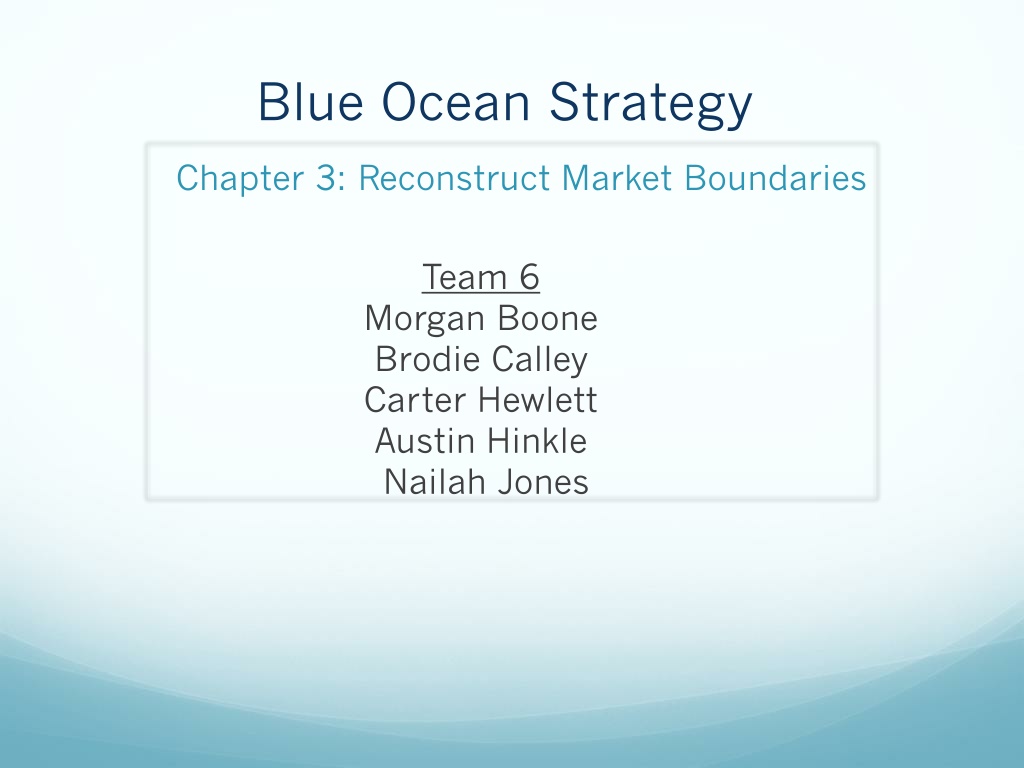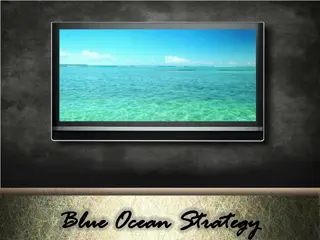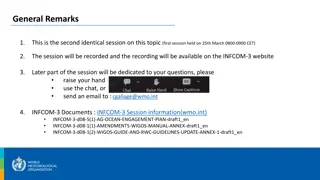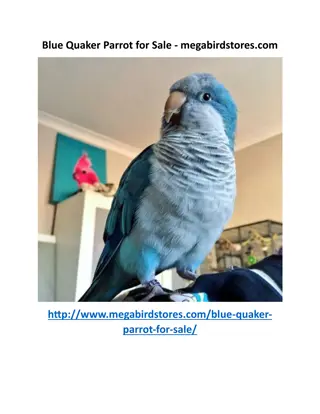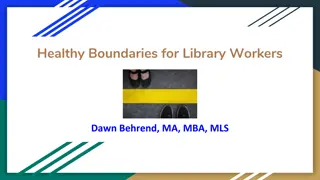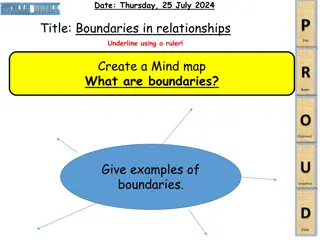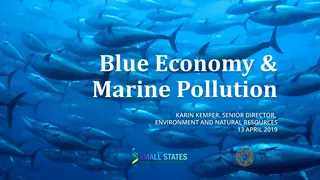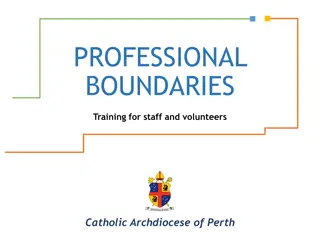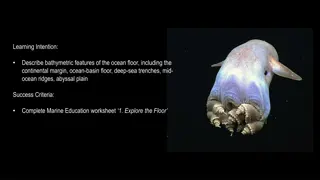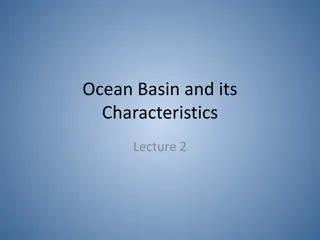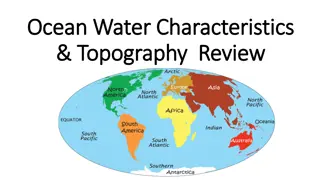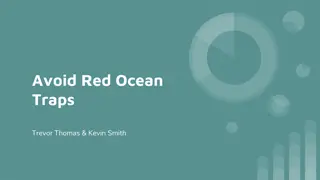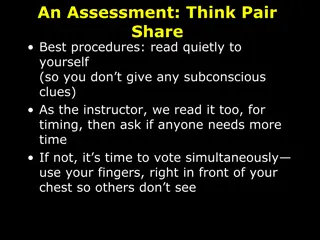Blue Ocean Strategy: Reconstructing Market Boundaries Overview
The presentation outlines the 6 Paths Framework of Blue Ocean Strategy, focusing on ways to create new market opportunities by challenging industry assumptions. It discusses looking across industries, strategic groups, buyer groups, complementary offerings, industry orientations, and timing. Emphasizing on breaking free from traditional competition to carve out uncontested market spaces.
Download Presentation

Please find below an Image/Link to download the presentation.
The content on the website is provided AS IS for your information and personal use only. It may not be sold, licensed, or shared on other websites without obtaining consent from the author. Download presentation by click this link. If you encounter any issues during the download, it is possible that the publisher has removed the file from their server.
E N D
Presentation Transcript
Blue Ocean Strategy Chapter 3: Reconstruct Market Boundaries Team 6 Morgan Boone Brodie Calley Carter Hewlett Austin Hinkle Nailah Jones
Current Event Wall Street Journal Colleges Spar Over Nursing Community campuses bid to offer upper-level courses; is opposed by four-year schools If California bill is passed, BSN degrees will become available through community colleges Path 2 Opens up competition between educational institutions Path 4 Trade up to major college, or trade down to community college
What companies tend to do Define their industry Look at the industries through strategic groups and try to stand out in the ones they play in Focus on the same buyer group whether it be purchaser, user, or influencer. Define the scope of the products and services offered Accept their industry s functional or emotional orientation Focus on the same point in time in formulating strategy.
The six assumptions mentioned in the previous slide are the assumptions that most companies tend to build their strategies upon By sticking to these assumptions, companies are trapped in competing in red oceans When the the enhanced alternatives are applied, competing in a blue ocean becomes realistic
Overview: 6 Paths Framework 6 basic approaches to remaking market boundaries Clear patterns for creating blue oceans Doesn t require special vision about the future, all focus on looking at familiar date from a new perspective
The 6 Paths 1. Alternative Industries 2. Strategic Groups 3. Buyer Groups 4. Complementary Product and Service Offerings 5. Functional-Emotional Orientation of an Industry 6. Time
Path 1: Look Across Alternative Industries Substitutes Product or services with different forms, but the same functionality Alternatives Products or services with different functions, but the same purpose NetJets
Strategy Canvas of NetJets 7 6 5 4 3 2 Private Jet NetJet Commercial Airline 1 0
How this can help Academy Rather than focusing on similar products, substitutes, market to new customers with new products, alternatives
Path 2: Look Across Strategic Groups Within Industries Strategic Groups A group of companies within an industry that pursue a similar strategy Strategic groups can usually be ranked based on two dimensions: 1. Price 2. Performance Each jump in dimension tends to include a corresponding jump i.e. as price increases, performance should increase as well
Companies try to compete within their strategic groups Mercedes doesn t focus on competing with Ford, but they do focus on outcompeting Jaguar Companies can create a Blue Ocean by understanding why consumers trade up or trade down Lexus offered the quality of a high-end Mercedes, but at the price of a lower-end Lincoln
Curves Curves began franchising in 1995. They based their strategy on why Women trade up to a health club, or trade down to a home workout tape. By cutting out all of the extras, they created an affordable fitness club that was just a fast as a home workout.
Path 3: Look Across the Chain of Buyers In most industries, competitors can agree on a common definition of who the target buyer is for that industry In reality, there is a series of buyers who are directly or indirectly involved in the buying decision Three groups are involved in the buying process Purchasers Users Influencers The purchasers of the product, who pay for it, may differ from the products actual users . There can also be important influencers of the product as well
Individual companies in an industry often target different segments of customers, but they typically end up targeting a single buyer group Challenging an industry s conventional approach to targeting customers can lead to the discovery or creation of a Blue Ocean By looking across buyer groups, companies can gain new insights about how to re-evaluate their strategies to target previously overlooked sets of buyers
Example Insulin Pens Typically directly sold and marketed to Doctors Started marketing towards the end consumer Created a new product/business (NovoPen) By questioning conventional definitions of who can and should be the target buyer, companies can often see new and vastly different ways to create or unlock value
Path 4: Look Across Complementary Product and Service Offerings Untapped value is often hidden in complementary products and services Think about what happens before, after, and during the product/service being used Expedia allows you to book your airline ticket, hotel, and rental car at the same time The majority of travelers need these accommodations when they travel
Admit Two? If you and your significant other wanted to see a movie, what services might make this easier? Although childcare is not included in the price of a movie ticket, nor is it part of the theatre experience, the ease of finding a babysitter affects the perceived value of going to the movies
Pain Points Identify potential pain points your customer may experience, and try to alleviate them prior Obtaining a hunting license can be done at Academy This alleviates the pain point of the customer having to buy their hunting gear at Academy and then having to go somewhere else to get the approved license Eliminates extra steps in the purchasing process
NABI A Hungarian bus company Realized that the key expenses in public transportation (busses) was not in the initial purchase, but in the repairs When busses were well repaired, they also ran on time and customers were happier with the experience
Fiberglass Lower powered engines More Space inside of bus Steel Hard to repair Less Spacious
Path 5: Look Across Functional or Emotional Appeal to Buyers Companies in similar industries tend to compete based on one of two appeals 1.Some industries compete principally on price and function, largely on calculations of utility Their appeal is considered to be rational 2. Others choose to compete largely on feelings associated with their product/service Their appeal is emotional The appeal of most products or services is rarely intrinsically one or the other
Over time, functionally oriented industries tend to become more functionally oriented and emotionally oriented industries become more emotionally oriented When companies are willing to challenge the functional-emotional orientation of their industry, they often find new market space
Emotionally Oriented Industries Offer many extras that add price without enhancing functionality By removing those extras, there is the possibility to create fundamentally simpler, lower-priced, lower-cost business models that customers would welcome Functionally Oriented Industries Can often give their products new life by incorporating elements of emotion In doing so, they can stimulate new demand
A burst of Blue Ocean creation is becoming prominent in a number of service industries, but in the opposite direction Many of them are moving from an emotional orientation to a functional orientation
Application to Academy Sports and Outdoors Academy competes on functionality Offers a wide range of products at affordable prices By adding in emotional appeals, such as family bonding while using their sports and outdoors products, or building comradery within a team, the brand would be associated with more than just tangible products
Path 6: Look Across Time All industries are subject to external trends Insights come from how the trend will change value to customers This approach is more difficult than the previously discussed approaches
Apple and iTunes An example of this is Apple launching iTunes in 2003 1990 s the market was flooded with illegal music file sharing Allowed customers to buy individual song iTunes was a huge success Average 2.5 million downloads per week Apple s iTunes unlocked a blue ocean in digital music
Summary: Conceiving New Market Space By thinking across conventional boundaries of competition, you can see how to make convention- altering, strategic moves that reconstruct established market boundaries and create Blue Oceans By considering the restructure of existing market elements across industry and market boundaries, firms will be able to free themselves from the head- to-head competition in red oceans
